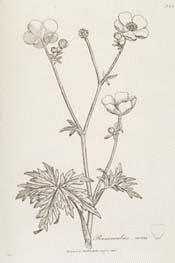
Botanical.com Home Page

|
Crowfoot, Upright Meadow
(Ranunculus acris)
Click on graphic for larger image
|
Crowfoot, Upright Meadow
Botanical: Ranunculus acris (LINN.)
Family: N.O. Ranunculaceae
---Synonyms---Gold Cup. Grenouillette.
---Part Used---Whole herb.
---Habitat---This Buttercup is a native of meadows and pastures in all the northern parts of Europe, and is very common in England, flowering in June and July.
The Upright Meadow Crowfoot, a familiar plant in our hay-fields, is recognized at once from all other Buttercups or Crowfoots by its tall flower-stalks not being furrowed, and its fruit-base, or receptacle, not being hairy. The stems are hollow, round, more or less covered with soft, silky hairs and very freely branching towards their summits, where they are terminated by numerous goldenyellow flowers.
---Description---The leaves vary a good deal in form, according to their position on the plant: the lower leaves are on long petioles (foot-stalks) and are comprised of numerous wide-spreading and deeply divided segments; the upper leaves are small, composed of few segments, simple in form and few in number. The root is perennial, though the plant itself dies down each autumn, and has many long, white fibres.
The petals of the flower are bright, shining yellow; the calyx is composed of five greenish-yellow spreading sepals. The centre of the flower, as in other Buttercups, is a clustering mass of stamens round the smooth, green immature seed-vessels, which develop into a round head of numerous small bodies called achenes.
Most of the Crowfoots are known to be acrid and some even to be poisonous, but this plant receives its Latin specific name of acris from its supposed intensity of acridity, for all parts of it are intensely acrid. It has been stated that even pulling it up and carrying it some little distance, has produced considerable inflammation in the palm of the hand, and that cattle will not readily eat it in the green state, and if driven by hunger to feed on it, their mouths become sore and blistered. According to Linnaeus, sheep and goats eat it, but cattle, horses and pigs refuse it. When made into hay, it loses its acrid quality, but then seems to be too hard and and stalky to yield much nourishment. The notion that the butter owes its yellow colour to the prevalence of buttercups in the meadows, is quite groundless - it is the richness of the pasture that communicates this colour to the butter and not these flowers which the cattle seldom or never touch willingly.
- Miss Pratt (Familiar Wild Flowers) states:
- 'Instances are common in which the wanderer in the meadow has lain down to sleep with a handful of these flowers beside him, and has awakened to find the skin of his cheek pained and irritated to a high degree, by the acrid blossoms having lain near it.'
Poetically, the associations of this plant are numerous. Gay tells us in The Shepherd's Oracle that it was worn by lovers at betrothal time, and its golden colour was dedicated to Hymcn in classical history. In France, it is termed the grenouillette, a name similar in meaning to its Latin generic name Ranunculus, a reference to the moist meadows in which it usually grows. In the astrological Herbals it was deemed a plant of Mars, on account of its acrid, fiery nature.
- Old authors say:
- 'this fiery and hot-spirited herb is not fit to be given inwardly, but that an ointment of the leaves and flowers will raise a blister and may be applied to the nape of the neck to draw rheum from the eyes,' and that mixed with a little mustard it raises a blister as perfectly as the Spanish Fly.
---Medicinal Action and Uses---The juice of the leaves takes away warts, and bruised together with the roots will act as a caustic. In violent headaches where pain is confined to one part, a plaster made of them often affords instant relief, and they have been used in gout with great success.
The fresh leaves formed part of a famous cure for cancer, practised by a Mr. Plunkett in 1794.
Thornton, in his Herbal of 100 years ago, says if a decoction of the plant be poured on ground containing worms, 'they will be forced to rise from their concealment.'
[Top]
Common Name Index
A MODERN HERBAL Home Page
Bear in mind "A Modern Herbal" was written with the conventional wisdom of the early 1900's. This should be taken into account as some of the information may now be considered inaccurate, or not in accordance with modern medicine.
© Copyright Protected 1995-2025 Botanical.com
|

